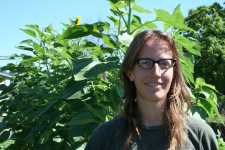Youth In Agriculture Growing Beyond Farms

BUCKEYE-Woodland Learning Urban Farm, located in Cleveland, OH, produces a variety of vegetable crops, including tomatoes and peppers, on just 1.5 acres. The farm is supported by The Green Corps, which is a work/study program of the Cleveland Botanical Gardens for students in the inner city.Â
This youth education component is a unique and important element to agriculture in the city, as many of the students taking part in the program have little-to-no outside growing experience. (Editor’s Note: The mission of Green Corps, according to the Cleveland Botanical Gardens, is to encourage life, work, and leadership skills by employing and educating high school students in areas such as sustainable agriculture, place-based learning, and community engagement.)
As traditional agriculture operations are generally passed down from one generation to the next, introducing youth fresh from the city to the opportunity of growing produce could supply the industry with the fresh blood it needs to stay relevant. Julia Ferguson, manager at Buckeye Farms as well as a GenNext Grower, took the time to answer a few questions regarding her experiences working with youth in agriculture in the city.Â
1. How did you get into urban agriculture as a young person in the city?
Ferguson: I became interested in urban agriculture as a tool for providing economic and ecological services in urban areas while pursuing a degree in urban planning. My interests in gardening and community development, and some well-founded research, led me to the conclusion that in some situations urban farms and community gardens can have incredibly positive impacts on blighted neighborhoods.
Over the past several years urban agriculture has begun to be recognized as an effective strategy for vacant land reutilization, particularly in Rust Belt cities like Cleveland. Our six Green Corps sites not only provide work and educational opportunities for high school youth, but also host weekly farm stands, have space for community members to grow their own gardens, and participate in community service projects across the city.
2. How have the young people you employ responded to working in agriculture?
Ferguson: For many of the youth in the program, this is not only their first job but also their first exposure to agriculture and horticulture. I think most of them really enjoy the work, and the related experience of being outside, learning about where food comes from, how to grow it, and how important physical activity and good nutrition are to a healthy body. Many of the students take on the work eagerly, from planting seedlings to building compost piles. Harvest and selling at the markets is always a favorite activity.
We stress during interviews that this is a very physical job and many of the youth enjoy this aspect of it. We also spend a good deal of time in educational lessons about soil science, integrated pest management, and organic growing methods to supplement what they are learning in the field.
3. What are a few of the misconceptions most of the students have about farming?
Ferguson: I think many of our youth, as well as the general population, greatly underestimate the amount of work and effort that is required to grow food. They are not anticipating so much heavy physical labor or the amount of dirt that gets under their nails.
Like many people, the youth often assume that all bugs are bad. This is why we use every opportunity to teach about integrated pest management and the difference between beneficial and non-beneficial insects. The youth and many of our farm stand customers alike are surprised to learn what can and cannot grow in our climate. We get frequent requests for locally grown pineapples and oranges.
4. How does urban ag positively impact the lives of the participating youth?
Ferguson: The positive impacts of this work to the youth involved are innumerable. Green Corps participants are learning about growing food and building farms, but the long-term life skills and lessons go far beyond this specific work.
We don’t expect all of our students to eventually become farmers, but engaging in teamwork and problem solving daily allows them to build these skills for future jobs. Many of them finish the summer with a much greater understanding of how to grow food and how important it is to make healthy decisions for your body and the environment.
The youth are so proud of their efforts through the summer. They not only get to watch seeds they planted in May turn into a bountiful harvest, but they get to share it with their neighbors, friends, and family.
5. What tips can you share with operations looking to employ urban youth?
Ferguson: Make sure you have a curriculum or training schedule in place to provide the youth with the tools necessary to be successful in their work. This means having a passionate and dedicated staff and community support network. Be willing to be flexible and creative in
the field daily in order to meet both your production needs and the needs of the youth participants. It is an incredibly rewarding experience for all involved.
For more information on Buckeye-Woodland Learning Urban Farm, go to www.cbgarden.org/lets-learn/green-corps.aspx.









